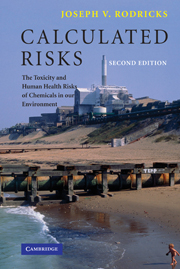Book contents
- Frontmatter
- Contents
- Preface to the first edition
- Preface to the second edition
- List of abbreviations
- Prologue
- 1 Chemicals and chemical exposures
- 2 From exposure to dose
- 3 From dose to toxic response
- 4 Toxic agents and their targets
- 5 Carcinogens
- 6 Identifying carcinogens
- 7 Risk assessment I: some concepts and principles
- 8 Risk assessment II: applications
- 9 Risk assessment III: new approaches, new problems
- 10 Risk assessment IV: the courtroom
- 11 The management of risk
- 12 A look ahead
- Sources and recommended reading
- Index
7 - Risk assessment I: some concepts and principles
Published online by Cambridge University Press: 25 August 2009
- Frontmatter
- Contents
- Preface to the first edition
- Preface to the second edition
- List of abbreviations
- Prologue
- 1 Chemicals and chemical exposures
- 2 From exposure to dose
- 3 From dose to toxic response
- 4 Toxic agents and their targets
- 5 Carcinogens
- 6 Identifying carcinogens
- 7 Risk assessment I: some concepts and principles
- 8 Risk assessment II: applications
- 9 Risk assessment III: new approaches, new problems
- 10 Risk assessment IV: the courtroom
- 11 The management of risk
- 12 A look ahead
- Sources and recommended reading
- Index
Summary
Consider the following situations and the questions that arise as a result.
Individuals working in a petroleum refinery are routinely exposed, over the course of an eight-hour work day, to the volatile hydrocarbon benzene, a constituent of petroleum that has been established through epidemiology studies, in quite different occupational situations, as a cause of human leukemia. Is it possible to understand whether and to what extent these specific, unstudied refinery workers are at risk of developing leukemia?
Because benzene is a constitute of gasoline and some other fuels, and because it is so volatile, virtually all of us are exposed, almost continuously, to a certain level in the air we breathe. In some cases, because of fuel leaks and spills, ground waters and surface waters have become contaminated with benzene. What can be said about the threats to health, if any, we all face from these relatively low levels of exposure through our environment?
A compound called methylmercury comes to be present in fish because of various industrial releases of mercury to the environment, and even through its migration from some natural ores present in the seabed. The released mercury undergoes a chemical conversion brought about by the natural biochemical processes of microbes, and becomes methylmercury. The latter compound is readily taken up into fish and because, unlike the inorganic form of mercury from which it derives, it is fat-soluble, it tends to accumulate to a greater degree in oilier species. In some (but not all) studies in certain human populations with relatively high levels of methylmercury intake, children born of fish-consuming women exhibit a variety of more or less serious neurological and learning deficits. Are such deficits to be expected in children of the vast majority of women of child-bearing age who are exposed to lower levels of methylmercury through this source?
[…]
Information
- Type
- Chapter
- Information
- Calculated RisksThe Toxicity and Human Health Risks of Chemicals in our Environment, pp. 202 - 214Publisher: Cambridge University PressPrint publication year: 2006
